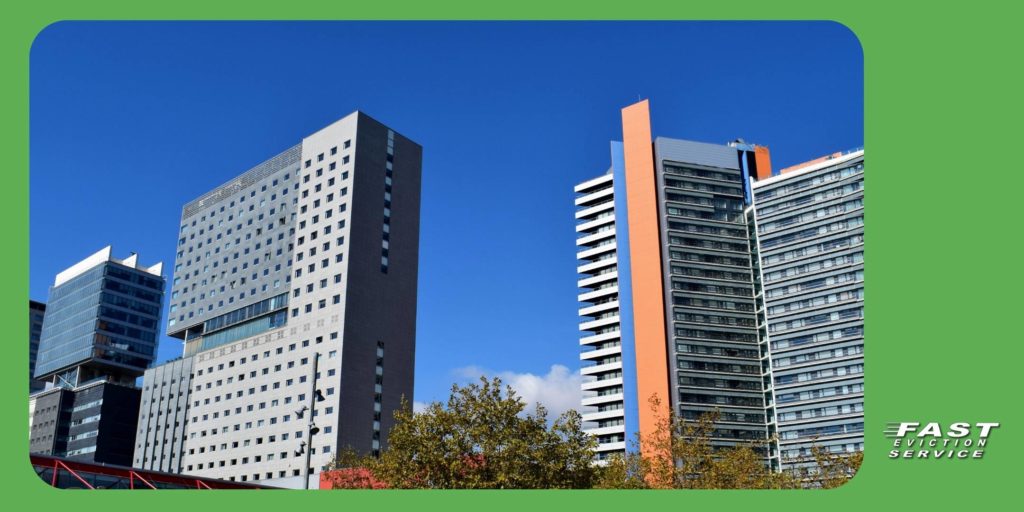Updated 07/05/24
Navigating the complexities of commercial property management can be challenging, especially when it comes to evictions. As a landlord, understanding the specifics of eviction notices for commercial tenancies in California is crucial to protect your interests and comply with state laws. Evicting a commercial tenant involves a series of legal steps that must be followed precisely to avoid complications and potential legal disputes. In this article, we’ll break down the essential elements of eviction notices for commercial tenancies in California and guide you through the process to ensure a smooth and lawful eviction.

Eviction notices for commercial tenancies differ significantly from those for residential properties. The requirements and procedures are governed by specific statutes and often involve more complex legal considerations. Whether dealing with non-payment of rent, lease violations, or other issues, landlords must issue the correct type of eviction notice and adhere to the appropriate timelines. Let’s explore the key steps and legal requirements involved in serving eviction notices for commercial tenancies in California.
Understanding Grounds for Eviction
Before issuing an eviction notice for commercial tenancies, it’s important to understand the legal grounds for eviction. Common reasons include non-payment of rent, breach of lease terms, illegal activities, or property damage. Each ground for eviction has specific legal requirements and must be clearly articulated in the eviction notice. Ensuring that you have a valid reason for eviction and that it is properly documented is the first step in the process.
Types of Eviction Notices
In California, there are several types of eviction notices for commercial tenancies, each serving a different purpose:
- Three-Day Notice to Pay Rent or Quit: This notice is used when a tenant has failed to pay rent. It gives the tenant three days to pay the overdue rent or vacate the premises.
- Three-Day Notice to Perform Covenants or Quit: This notice is applicable when a tenant violates a term of the lease, such as subleasing without permission or failing to maintain the property. The tenant has three days to correct the violation or move out.
- Three-Day Notice to Quit: This notice is used for serious lease violations that cannot be remedied, such as conducting illegal activities on the premises. The tenant must vacate within three days.
- Thirty-Day or Sixty-Day Notice to Terminate Tenancy: This notice is used for terminating a month-to-month tenancy. The notice period depends on the duration of the tenancy; a 30-day notice is required if the tenancy is less than a year, and a 60-day notice is required if it is longer.
Drafting and Serving the Notice
When drafting eviction notices for commercial tenancies, it’s essential to include specific information to ensure the notice is legally valid. The notice must clearly state the tenant’s name, the property address, the reason for eviction, the amount of unpaid rent (if applicable), and the deadline for compliance or vacating the property. The notice should also reference the relevant lease provisions and state the consequences of failing to comply.
Proper service of the eviction notice is critical. In California, eviction notices for commercial tenancies can be served in person, by substituted service (leaving the notice with someone at the premises and mailing a copy), or by posting the notice on the property and mailing a copy. Following the correct service procedure ensures the notice is legally enforceable and prevents delays in the eviction process.
Following Up with Legal Action
If the tenant fails to comply with the eviction notice, the next step is to file an unlawful detainer lawsuit. This legal action seeks to obtain a court order to remove the tenant from the property. The lawsuit must be filed in the county where the property is located, and the tenant must be served with the court documents. The tenant has a limited time to respond, and if they contest the eviction, a court hearing will be scheduled.
Preparing for Court
Winning an eviction case in court requires thorough preparation. Gather all relevant documents, including the lease agreement, payment records, communication logs, and a copy of the eviction notice. Be prepared to present evidence and testify about the reasons for eviction and the steps you have taken to comply with legal requirements. It’s often advisable to seek legal representation to navigate the complexities of the court process and enhance your chances of a favorable outcome.
Closing Thoughts
Understanding and correctly implementing eviction notices for commercial tenancies in California is crucial for landlords. By familiarizing yourself with the types of notices, ensuring proper drafting and service, and preparing for potential legal action, you can protect your property and enforce your rights effectively. Remember, the key to a successful eviction is to follow the legal procedures meticulously and seek professional advice when necessary. With the right approach, you can manage your commercial property efficiently and handle evictions lawfully.

